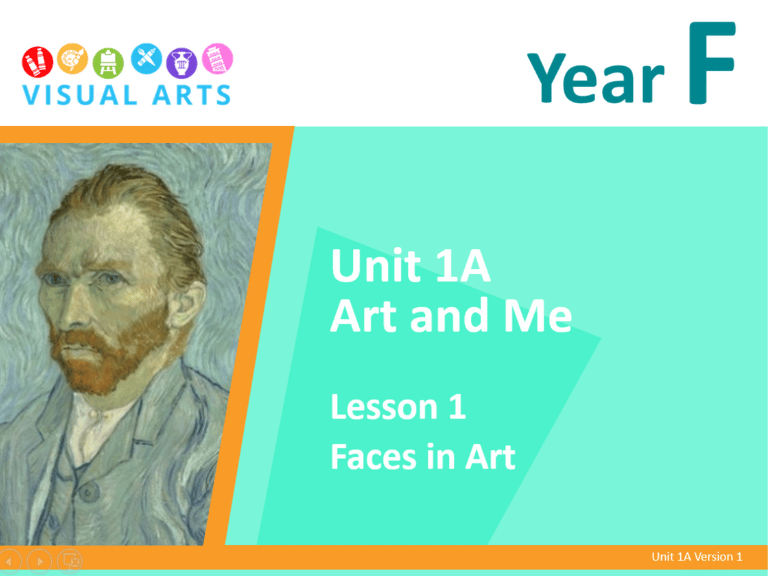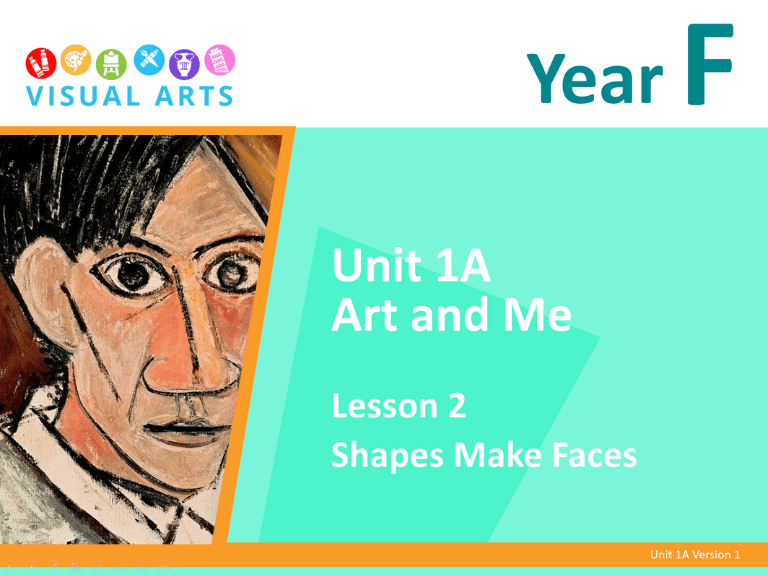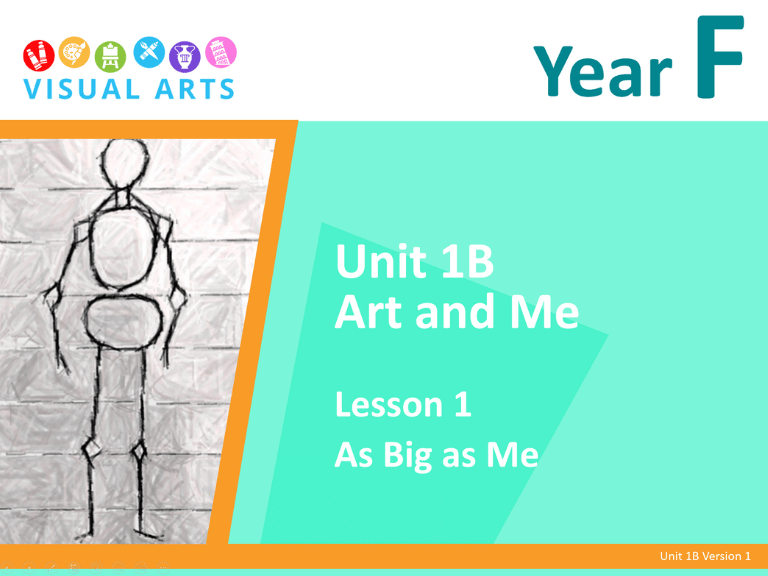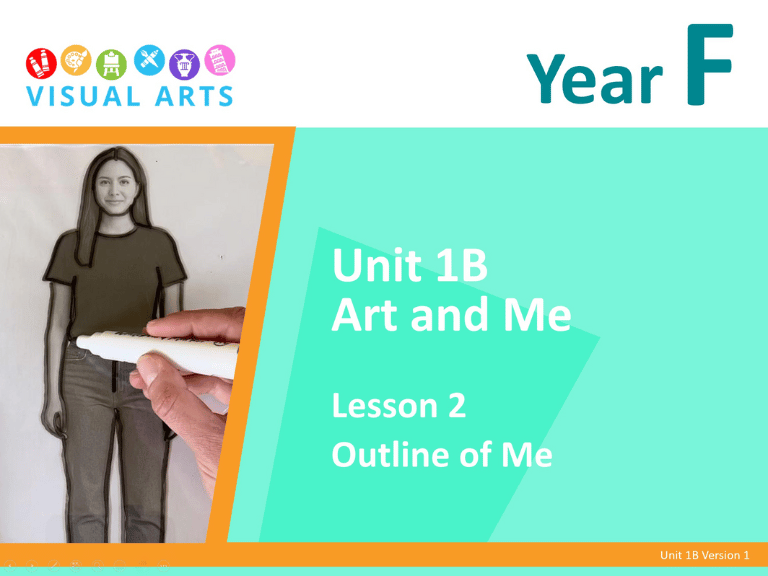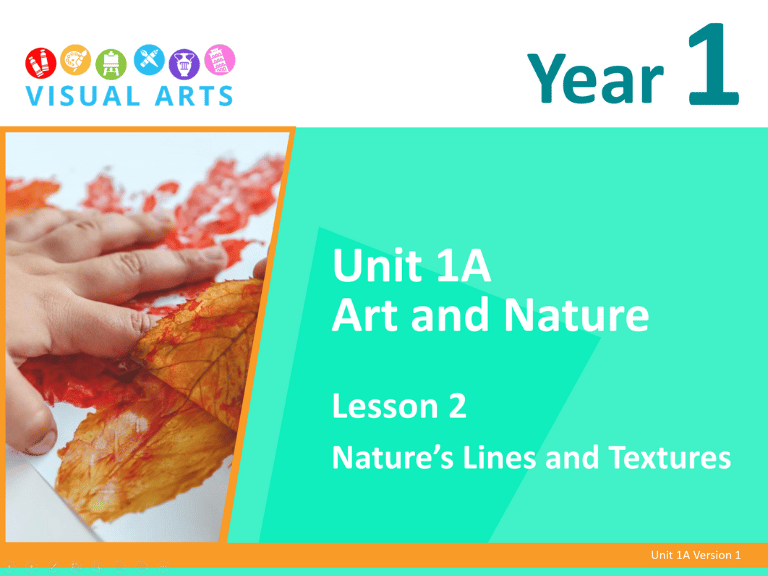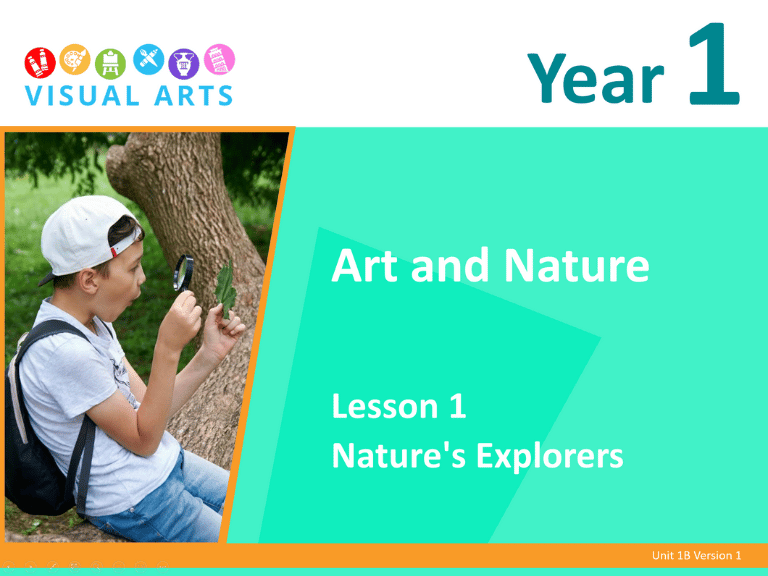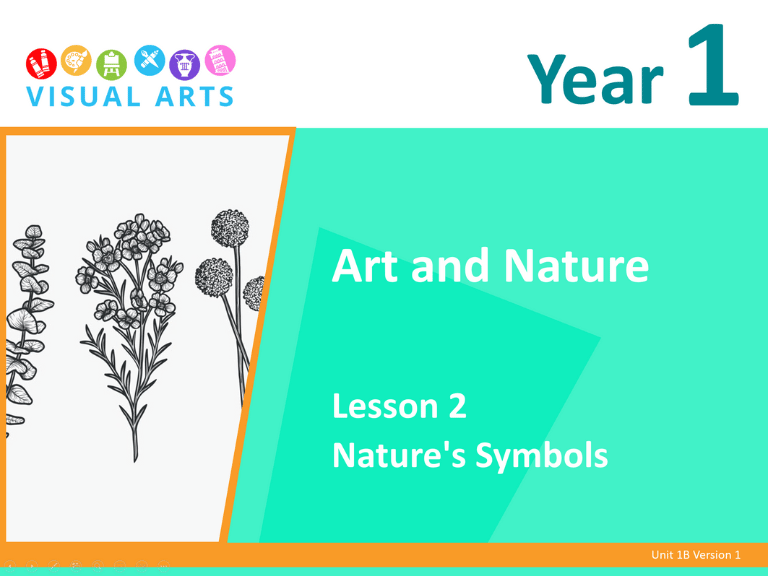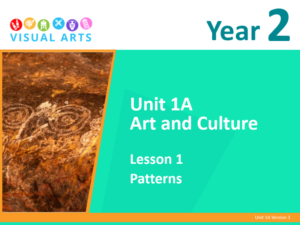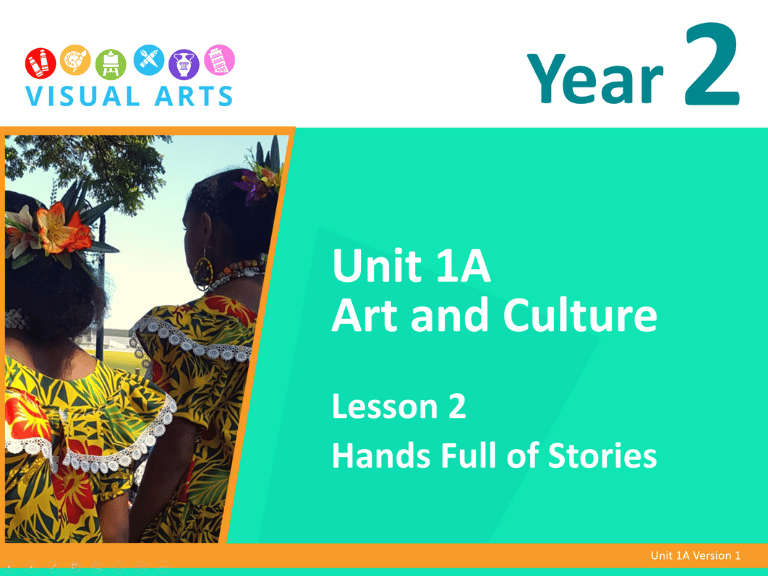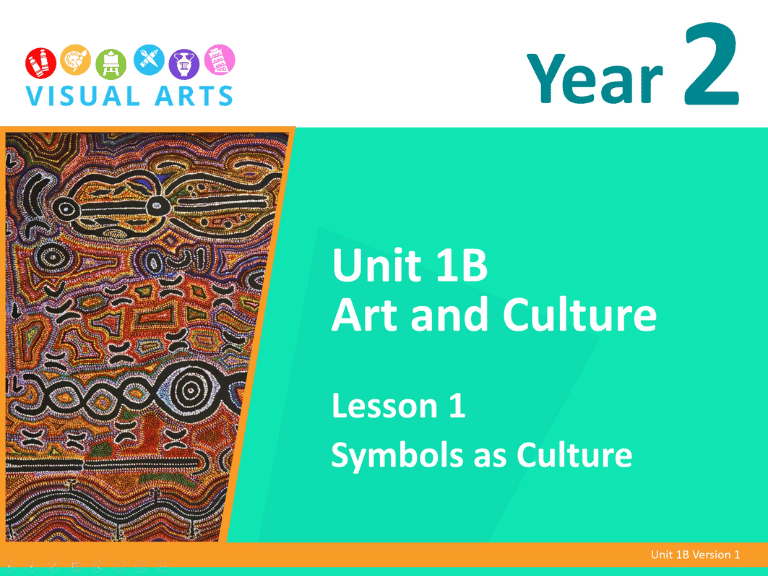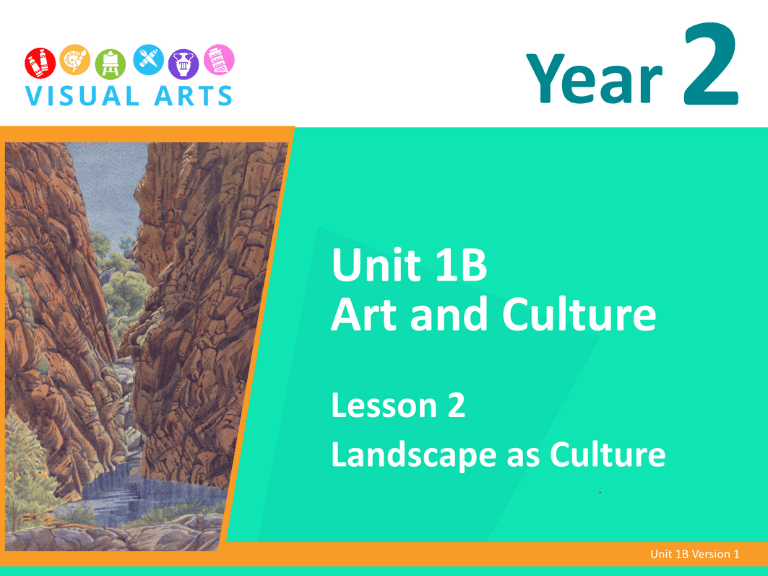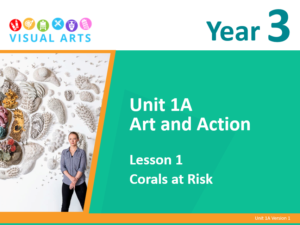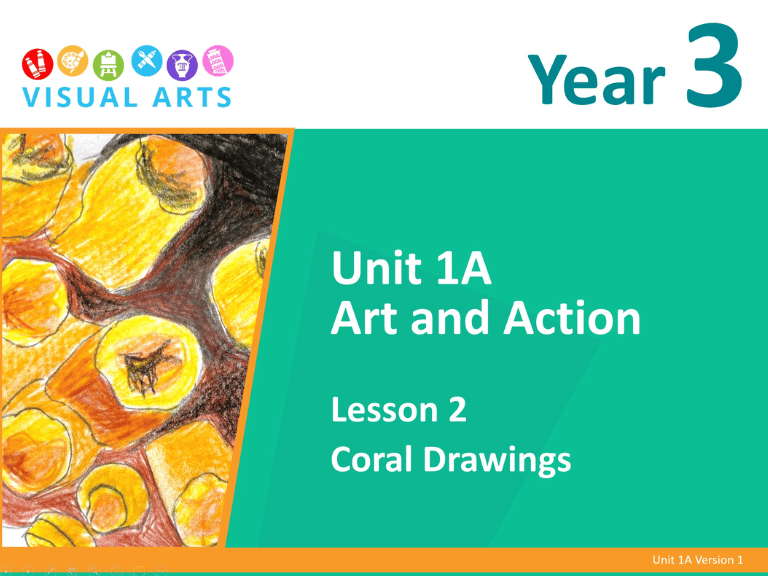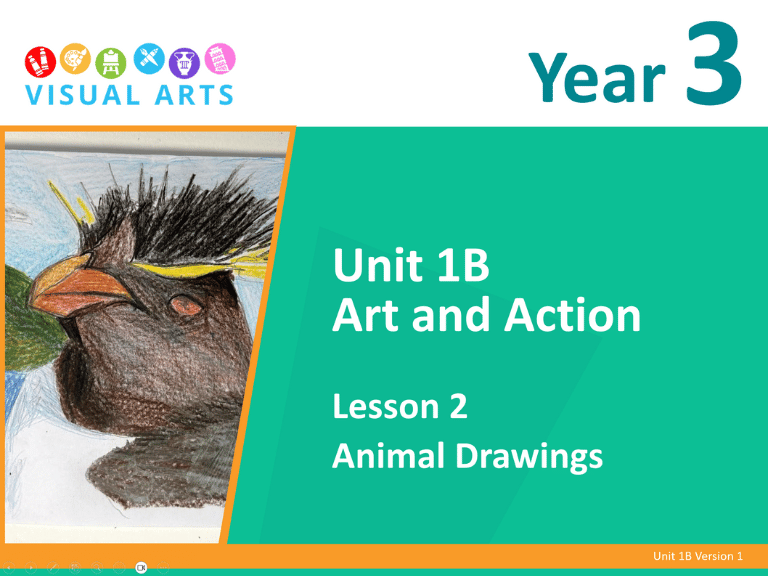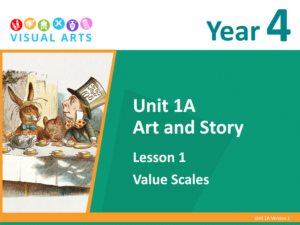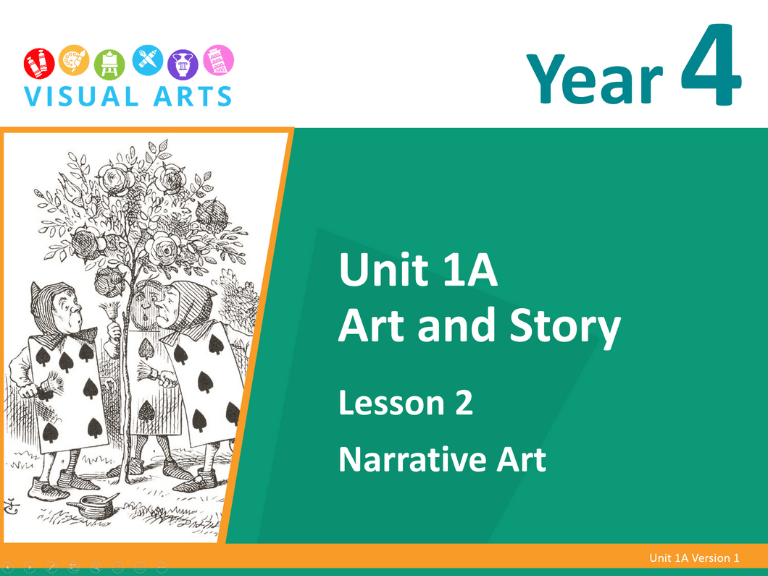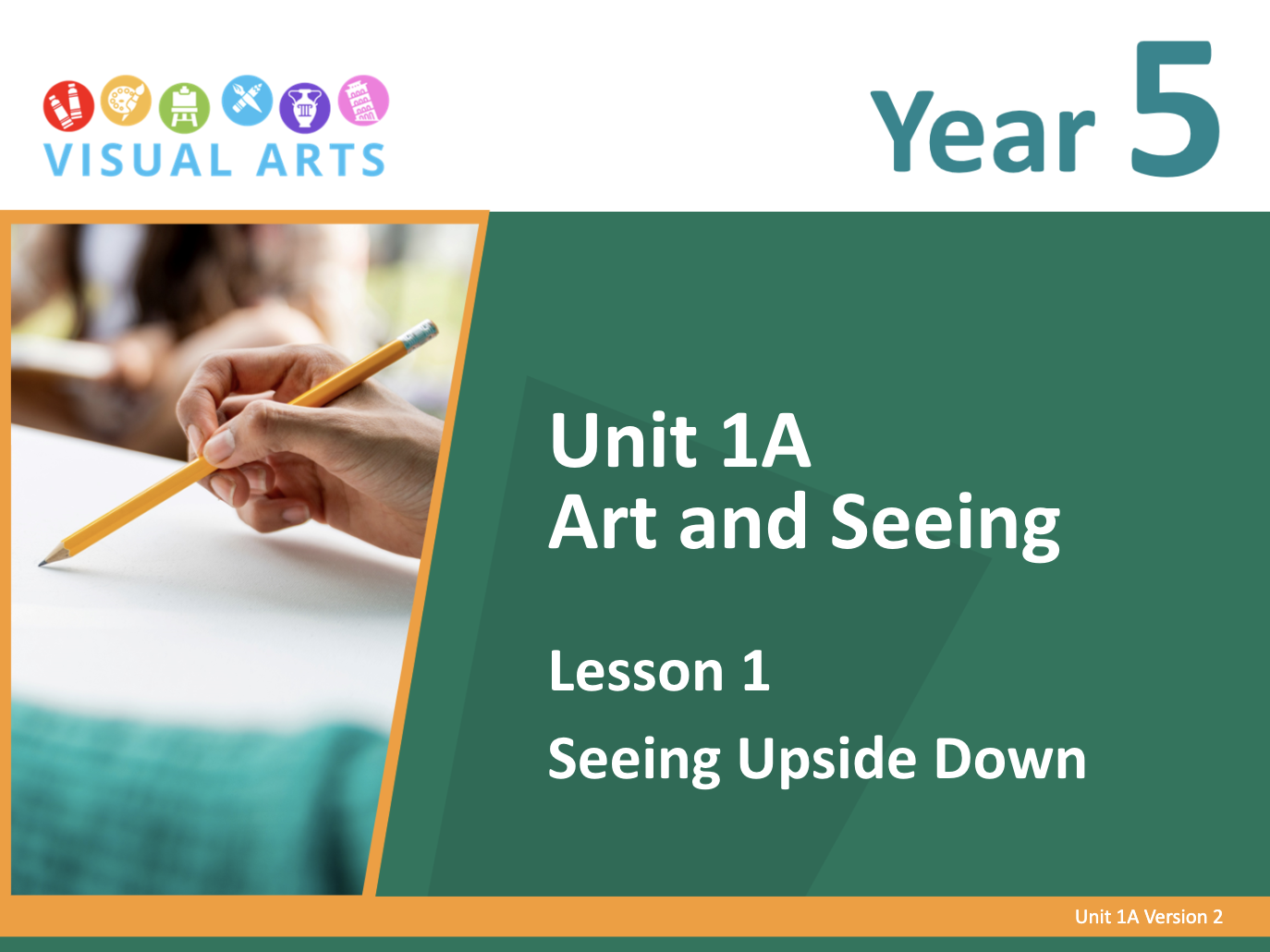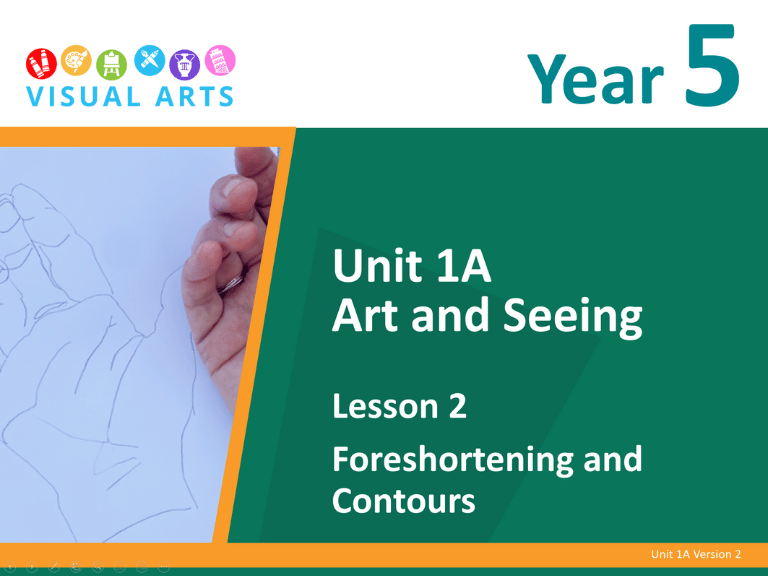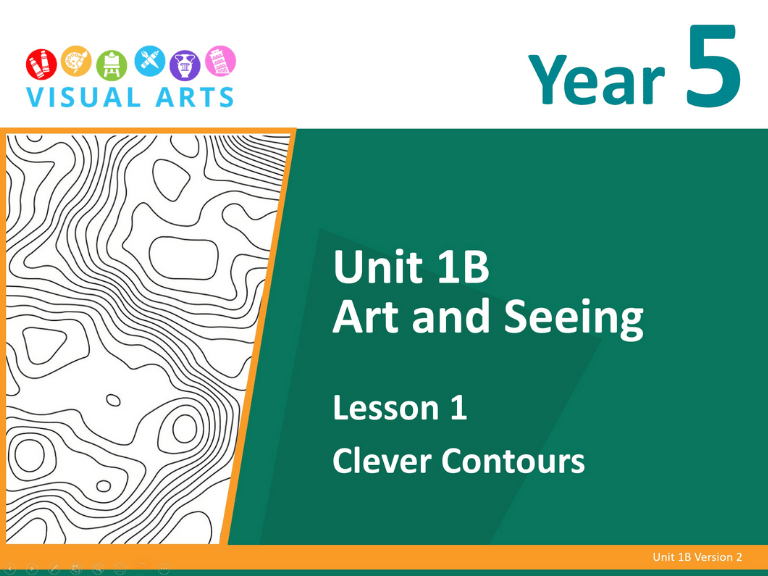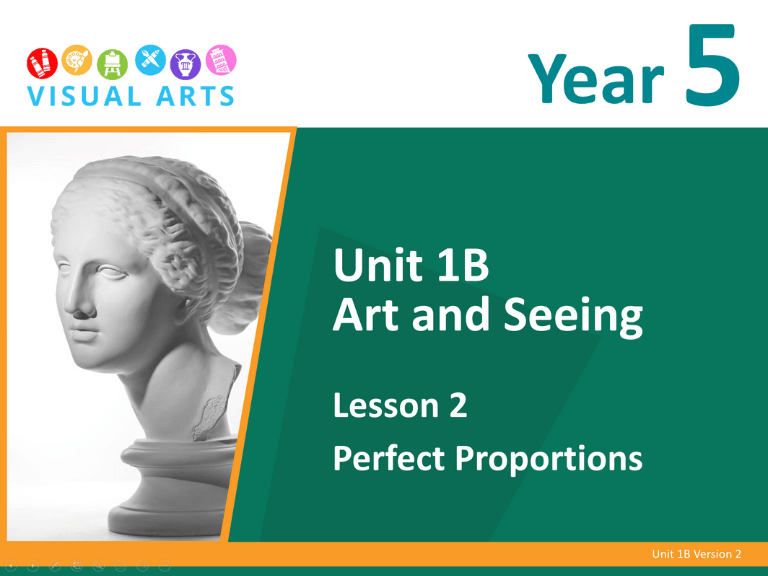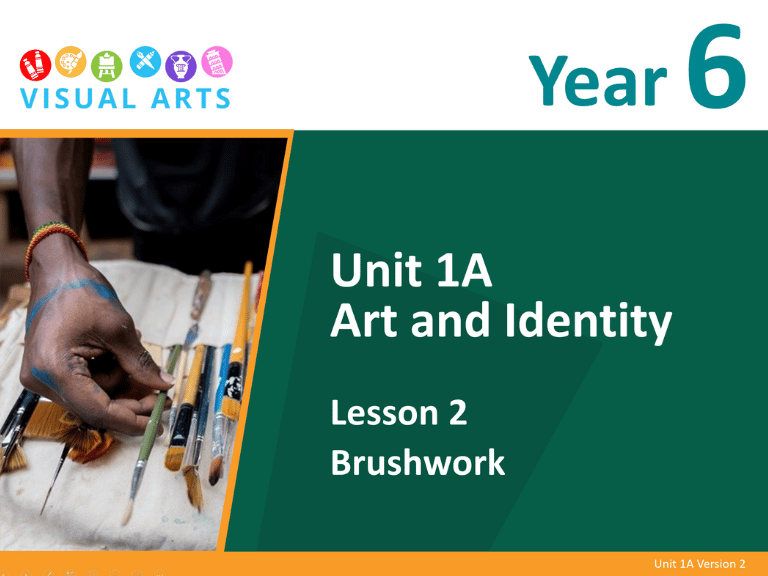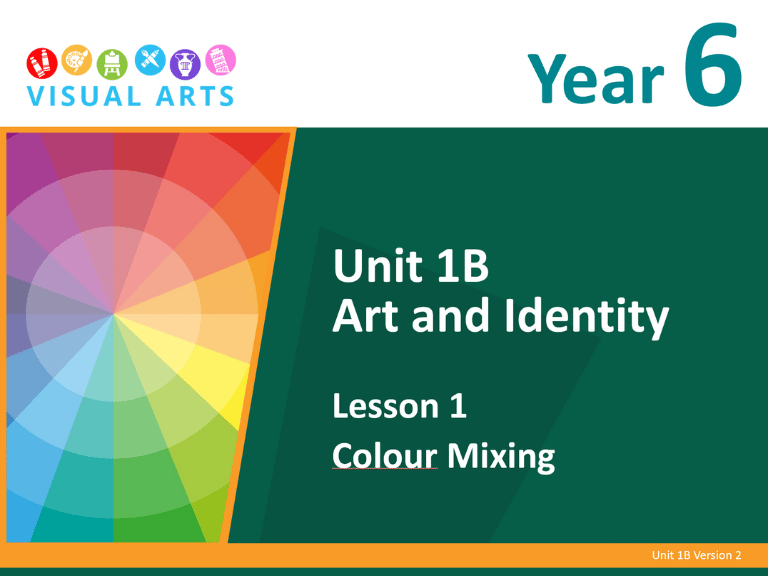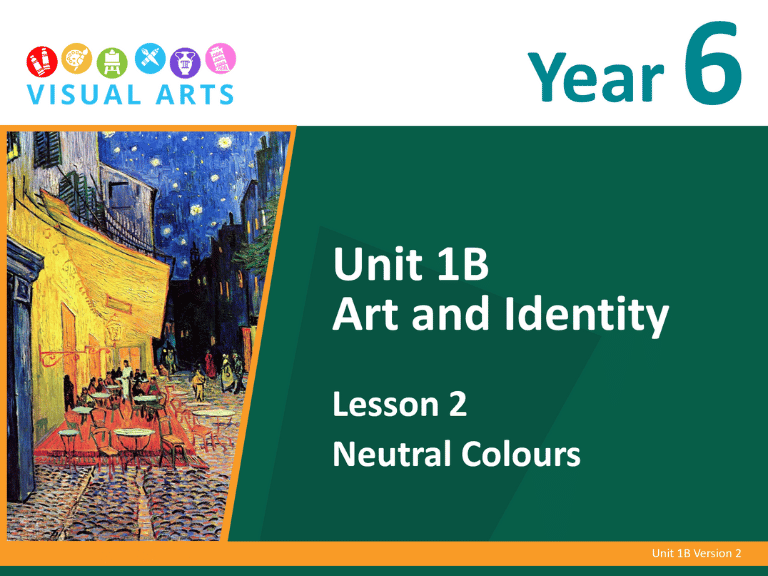Love what you see? Explore hundreds of FREE lessons in My School Box – join FREE today!
Visual Arts - Unit 1
Share this page:
Starter Lessons
Unit Overviews
Foundation Year, Unit 1A: Art and Me
Unit Description
In the ‘Art and Me’ unit, students will explore their significance within their families and homes through drawing, painting, and mixed media, focusing on how their art can reflect their identities. In the first part of the unit, Unit 1A students learn how to represent themselves in art through self-portraiture. They will experiment with various materials and techniques, gaining agency in their artistic choices while recognising the importance of art as a means of expression. The unit will culminate in an interactive showcase where students present their creations, celebrating their unique perspectives and the connections between their art and personal experiences.
Overview
This unit aligns with the Australian Curriculum content descriptions:
- Exploring and Responding: explore where, why and how visual arts are created and/or presented across cultures, times, places and/or other contexts.
- Developing practices and skills: experiment with a range of ways to use visual conventions, visual arts processes and materials.
- Creating and making: use visual conventions, visual arts processes and materials to create artworks that communicate ideas, perspectives and/or meaning.
- Presenting and Performing: share and/or display artworks and/or visual arts practice in informal settings.
Learning Objectives
Each of the nine lessons learning objectives:
- In this lesson we will understand that shapes make a face.
- In this lesson we will use shapes and lines to draw a detailed self-portrait.
- In this lesson, we will learn the names of colours and how to mix them.
- In this lesson, we will mix colours to paint our self-portrait.
- In this lesson, we will make a collage by arranging warm and cool colours.
- In this lesson, we will make a collage self-portrait using warm or cool colours.
- In this lesson, we will learn how to create different patterns.
- In this lesson, we will complete our self-portrait using colour, collage and pattern.
- In this lesson, we will reflect on our learning and share our artwork.
Success Criteria
- L1: Understand the shapes and lines that make up a face and draw them in the right place.
- L2: Notice the details of your face and draw these using shapes and lines.
- L3: Name primary and secondary colours and mix them.
- L4: Make colour choices and paint mixed colours onto the self-portrait.
- L5: Create a warm and cool colour collage.
- L6: Choose warm or cool colours, cut and stick shapes to make a face.
- L7: Use shapes and lines to make colourful patterns.
- L8: Apply skills and techniques to make a mixed media self-portrait.
- L9: Reflect on learning and present artwork to others.
Assessment
Continuous assessments
Continuous assessments are used to ascertain whether the knowledge recently taught has been understood by the student. These include oral tasks administered to individual students or tasks administered to the whole class for an entire lesson.
Final assessment
The final assessment occurs at the end of the unit in Week 9 and consists of a final summative review of their self-portraits, art tasks to demonstrate skills and reflection.
Foundation Year, Unit 1B: Art and Me
Unit Description
In the ‘Art and Me’ unit, students will explore their significance within their families and homes through drawing, painting, and mixed media, focusing on how their art can reflect their identities. In the first part of the unit, Unit 1A students learn how to represent themselves in art through self-portraiture. They will experiment with various materials and techniques, gaining agency in their artistic choices while recognising the importance of art as a means of expression. The unit will culminate in an interactive showcase where students present their creations, celebrating their unique perspectives and the connections between their art and personal experiences.
Overview
This unit aligns with the Australian Curriculum content descriptions:
- Exploring and Responding: explore where, why and how visual arts are created and/or presented across cultures, times, places and/or other contexts.
- Developing practices and skills: experiment with a range of ways to use visual conventions, visual arts processes and materials.
- Creating and making: use visual conventions, visual arts processes and materials to create artworks that communicate ideas, perspectives and/or meaning.
- Presenting and Performing: share and/or display artworks and/or visual arts practice in informal settings.
Learning Objectives
Each of the nine lessons’ learning objectives:
- In this lesson, we will learn how to draw ourselves in proportion.
- In this lesson, we will learn how to draw an outline and add details about ourselves.
- In this lesson, we will blend and layer colour to create a radiating line background.
- In this lesson, you will create a two-sided artwork about yourself.
- In this lesson, we will use a photograph to draw the outline of a family member in proportion.
- In this lesson, we will use a photograph to draw detailed pictures of our family members, so they all look different.
- In this lesson, we will use blending and layering to colour in our family members.
- In this lesson, you will create your own mobile using radiating lines and attach your colourful family members.
- In this lesson, we will reflect on our learning and share our artwork.
Success Criteria
- L1: Draw body parts in proportion and create a picture of yourself using shapes and lines.
- L2: Draw an outline in proportion with details.
- L3: Choose colours, draw radiating lines and blend and layer paint.
- L4: Draw an outline in proportion, blend and layer colours and cut your artwork into a shape.
- L5: Use a photograph to study a family member and draw the outline.
- L6: Use the correct proportion and add details to make each family member look like themselves.
- L7: Choose colours and blend, layer and block these.
- L8: Draw, colour and cut out artwork to make a mobile.
- L9: Reflect on learning and present artwork to others.
Assessment
Continuous assessments
Continuous assessments are used to ascertain whether the knowledge recently taught has been understood by the student. These include oral tasks administered to individual students or tasks administered to the whole class for an entire lesson.
Final assessment
The final assessment occurs at the end of the unit in Week 9 and consists of a final summative review of their self-portraits, art tasks to demonstrate skills and reflection.
Year 1, Unit 1A: Art and Nature
Unit Description
In the Art and Nature Unit, students will create art focused on animals, plants and shapes found in nature through drawing, painting and 3D projects. They will explore various materials and techniques, making choices to express their ideas and observations. The unit will conclude with a museum display of their creations, providing an opportunity for students to share their artistic explorations with others.
Overview
This unit aligns with the Australian Curriculum content descriptions:
- Exploring and Responding: explore where, why and how visual arts are created and/or presented across cultures, times, places and/or other contexts.
- Developing practices and skills: experiment with a range of ways to use visual conventions, visual arts processes and materials.
- Creating and making: use visual conventions, visual arts processes and materials to create artworks that communicate ideas, perspectives and/or meaning.
- Presenting and Performing: share and/or display artworks and/or visual arts practice in informal settings.
Learning Objectives
Each of the nine lessons learning objectives:
-
L1: Learn how to use natural objects to make colourful artwork.
-
L2: Learn how to draw objects that we see in nature.
-
L3: Use dark and light colours to draw a natural object.
-
L4: Use your skills and techniques to create a nature-based artwork.
-
L5: Make a collage out of natural objects.
-
L6: Use natural objects to copy an insect.
-
L7: Make a 3D insect from clay and natural objects.
-
L8: Make a 3D habitat from natural objects and clay.
-
L9: Reflect on our learning and share our artwork.
Success Criteria
- L1: Explore texture by creating leaf rubbings and use warm and cool colours to enhance contrast in artwork.
- L2: Observe natural objects closely and draw an observational leaf using lines, shapes, and textures.
- L3: Blend light and dark colours to show depth and form; colour the leaf drawing from L2.
- L4: Apply a range of skills to create a leaf-inspired artwork using rubbings, contrast, blending, and line work.
- L5: Learn about collage and create a habitat using natural materials with depth, texture, and layering.
- L6: Create a 3D collage insect using natural objects and explore detailed construction through observation.
- L7: Use tools and observation to sculpt a 3D insect from clay and natural objects with realistic detail.
- L8: Create a 3D clay habitat using natural objects; model, carve, join, and combine materials creatively.
- L9: Complete three final tasks and select two artworks to present in a class Art Walk.
Assessment
Continuous assessments
Continuous assessments are used to ascertain whether the knowledge recently taught has been understood by the student. These include oral tasks administered to individual students or written tasks administered to the whole class for an entire lesson. Written tasks are completed in the Student Workbook.
Final assessment
The final assessment occurs at the end of the unit in Week 9 and consists of a final summative installation of their corals, art analysis tasks and two final reflection tasks.
Year 1, Unit 1B: Art and Nature
Unit Description
In the Art and Nature Unit, students will create art focused on animals, plants and shapes found in nature through drawing, painting and 3D projects. They will explore various materials and techniques, making choices to express their ideas and observations. The unit will conclude with a museum display of their creations, providing an opportunity for students to share their artistic explorations with others.
Overview
This unit aligns with the Australian Curriculum content descriptions:
- Exploring and Responding: explore where, why and how visual arts are created and/or presented across cultures, times, places and/or other contexts.
- Developing Practices and Skills: experiment with a range of ways to use visual conventions, visual arts processes and materials.
- Creating and Making: use visual conventions, visual arts processes and materials to create artworks that communicate ideas, perspectives and/or meaning.
- Presenting and Performing: share and/or display artworks and/or visual arts practice in informal settings.
Learning Objectives
Each of the nine lessons learning objectives:
- L1: Look closely at a plant to make an observational drawing.
- L2: Turn a drawing of a plant into a symbol.
- L3: Create a pattern inspired by a plant.
- L4: Create a relief print of the design.
- L5: Create a clay model of a plant.
- L6: Add surface texture to the clay model.
- L7: Mix colours to paint the clay model realistically.
- L8: Plan and exhibit a museum display.
- L9: Reflect on our learning and share our exhibit.
Success Criteria
- L1: Identify and record three details, use contour and hatching to capture the plant’s form and add labels.
- L2: Reduce an object to its recognisable features to create a symbol using smooth lines.
- L3: Create a pattern from a repeated plant design.
- L4: Design a printing plate and cleanly print this several times to make a repeated pattern.
- L5: Use at least two clay techniques to create a model of a plant.
- L6: Identify textures and use tools and techniques to recreate them in the clay.
- L7: Mix paints and apply colour carefully to create a realistic appearance on the clay model.
- L8: Use a sketch map to plan and then arrange artwork to create balance and connection, including labels to add explanation.
- L9: Complete three final tasks and select two artworks to present in a class Art Walk.
Assessment
Continuous Assessments
Continuous assessments are used to ascertain whether the knowledge recently taught has been understood by the student. These include oral tasks administered to individual students or written tasks administered to the whole class for an entire lesson. Written tasks are completed in the Student Workbook.
Final Assessment
The final assessment occurs at the end of the unit in Week 9 and consists of a final summative exhibition of their museum display, art analysis tasks and two final reflection tasks.
Year 2, Unit 1A: Art and Culture
Unit Description
In the ‘Art and Culture’ unit, students will explore the significance of art in various cultures through drawing, painting and printmaking, focusing on cultural celebrations and traditions from around the world. They will experiment with different techniques and materials to express their understanding of the importance of art as a form of cultural expression. The unit will culminate in a mixed media project where students create a ‘cultural artifacts’ treasure box to share their work.
Overview
This unit aligns with the Australian Curriculum content descriptions:
- Exploring and Responding: explore where, why and how visual arts are created and/or presented across cultures, times, places and/or other contexts.
- Developing practices and skills: experiment with a range of ways to use visual conventions, visual arts processes and materials.
- Creating and making: use visual conventions, visual arts processes and materials to create artworks that communicate ideas, perspectives and/or meaning.
- Presenting and Performing: share and/or display artworks and/or visual arts practice in informal settings.
Learning Objectives
Each of the nine lessons learning objectives:
-
L1: In this lesson, we will learn how to draw organic shapes filled with patterns.
-
L2: In this lesson, we will learn how to draw patterns inspired by mehndi design.
-
L3: In this lesson, we will learn how to draw colourful geometric patterns.
-
L4: In this lesson, you will draw and paint colourful Islamic patterns.
-
L5: In this lesson, we will learn how to use shapes, patterns and pictures in a relief print.
-
L6: In this lesson, we will use shapes, patterns and pictures to show our culture.
-
L7: In this lesson, we will create colourful artwork to show our culture.
-
L8: In this lesson, you will use patterns and printing to share special things about your culture.
-
L9: In this lesson, we will reflect on our learning and share our artwork.
Success Criteria
- L1: Use organic shapes and draw a range of patterns.
- L2: Use organic shapes and draw patterns to create a special design.
- L3: Draw geometric shapes and patterns using a colour scheme.
- L4: Use an analogous colour scheme and symmetry around a point.
- L5: Carve shapes, patterns and pictures to print a design.
- L6: Use shapes, patterns and pictures to show more about your culture.
- L7: Mix and paint your design, choosing colours to show more about your culture.
- L8: Create a colourful background, carve and print a design.
- L9: Reflect and present your learning.
Assessment
Continuous assessments
Continuous assessments are used to ascertain whether the knowledge recently taught has been understood by the student. These include oral tasks administered to individual students or tasks administered to the whole class for an entire lesson.
Final assessment
The final assessment occurs at the end of the unit in Week 9 and consists of a final summative review of their artwork, art tasks to demonstrate skills and reflection.
Year 2, Unit 1B: Art and Culture
Unit Description
In the ‘Art and Culture’ unit, students will explore the significance of art in various cultures through drawing, painting and printmaking, focusing on cultural celebrations and traditions from around the world. They will experiment with different techniques and materials to express their understanding of the importance of art as a form of cultural expression. The unit will culminate in a mixed media project where students create a ‘cultural artifacts’ treasure box to share their work.
Overview
This unit aligns with the Australian Curriculum content descriptions:
- Exploring and responding: explore where, why and how visual arts are created and/or presented across cultures, times, places and/or other contexts.
- Developing practices and skills: experiment with a range of ways to use visual conventions, visual arts processes and materials.
- Creating and making: use visual conventions, visual arts processes and materials to create artworks that communicate ideas, perspectives and/or meaning.
- Presenting and performing: share and/or display artworks and/or visual arts practice in informal settings.
Learning Objectives
Each of the nine lessons’ learning objectives:
- In this lesson, we will make a simple relief print of a symbol that represents something that is important to us.
- In this lesson, we will learn how to paint a landscape that is important to our culture.
- In this lesson, we will learn how to tell a story about a very special day, using only symbols and images.
- In this lesson, we will decorate the outside of our Treasure Boxes, where we will store all our artwork from this unit.
- In this lesson, we will learn how to build found object sculptures.
- In this lesson, we will learn to make a paper doll that shows the clothes we wear in our culture.
- In this lesson, we will use our symbol from L1 to make a pattern for a shared project.
- In this lesson, we will use our classmates’ patterns to weave together a shared piece of art.
- In this lesson, we will present the artworks inside our Treasure Boxes and explain what parts are interesting to us.
Success Criteria
- L1: Brainstorm new symbols to carve and print onto paper.
- L2: Paint a landscape using realistic colours.
- L3: Tell a story using only images and symbols.
- L4: Use natural colours, symbols, and visual stories to decorate the outside of a box.
- L5: Use everyday objects to make a sculpture.
- L6: Make paper-doll clothing that shows clothing worn for special occasions.
- L7: Create a pattern out of repeated symbols.
- L8: Weave a shared artwork out of all your classmates’ patterns.
- L9: Reflect and present your learning.
Assessment
Continuous Assessments
Continuous assessments are used to ascertain whether the knowledge recently taught has been understood by the student. These include oral tasks administered to individual students or tasks administered to the whole class for an entire lesson.
Final Assessment
The final assessment occurs at the end of the unit in Week 9 and consists of a final summative review of their artwork, art tasks to demonstrate skills and reflection.
Year 3, Unit 1A: Art and Action
Unit Description
In the ‘Art and Action’ unit, students will explore environmental advocacy and art activism while making a difference through the creation of clay species that have been impacted by human activity and climate change. They will learn techniques for building and decorating clay, emphasising the importance of careful choice-making. The unit will conclude with a collaborative clay installation, allowing students to present their art and share its purpose with others to inspire change.
Overview
This unit aligns with the Australian Curriculum content descriptions:
- Exploring and Responding: explore where, why and how visual arts are created and/or presented across cultures, times, places and/or other contexts.
- Developing practices and skills: experiment with a range of ways to use visual conventions, visual arts processes and materials.
- Creating and making: use visual conventions, visual arts processes and materials to create artworks that communicate ideas, perspectives and/or meaning.
- Presenting and Performing: share and/or display artworks and/or visual arts practice in informal settings.
Learning Objectives
Each of the nine lesson’s learning objectives:
- L1: In this lesson, we will research coral reef biomes and the artists that help them.
- L2: In this lesson, we will draw our coral carefully, showing all the important details we learned about.
- L3: In this lesson, we will learn clay techniques to make a patterned sea turtle.
- L4: In this lesson, we will learn how artist Courtenay Mattison creates clay corals to raise awareness of coral bleaching.
- L5: In this lesson, we will make our first detailed clay corals.
- L6: In this lesson, we will make our second detailed clay corals.
- L7: In this lesson, we will make our third detailed clay corals.
- L8: In this lesson, we will paint our corals.
- L9: In this lesson, we will create an installation of our clay corals, to raise awareness of coral bleaching.
Success Criteria
- L1: Find and understand facts about coral bleaching.
- L2: Draw what you see accurately and include important details that help others understand your coral.
- L3: Join clay pieces together strongly, build up clay shapes carefully, make textures and patterns in clay.
- L4: Explain how artists make art to raise awareness about climate change.
- L5: Create your first coral form using careful clay building techniques.
- L6: Work independently to create surface textures that match your coral’s real features.
- L7: Explain your creative choices and what you learned while making your coral.
- L8: Mix colours that match your coral research image and paint your coral.
- L9: Arrange your coral sculptures effectively as part of our class installation.
Assessment
Continuous assessments
Continuous assessments are used to ascertain whether the knowledge recently taught has been understood by the student. These include oral tasks administered to individual students or written tasks administered to the whole class for an entire lesson. Written tasks are completed in the Student Workbook.
Final assessment
The final assessment occurs at the end of the unit in Week 9 and consists of a final summative installation of their corals, art analysis tasks and two final reflection tasks.
Year 3, Unit 1B: Art and Action
Unit Description
In the ‘Art and Action’ unit, students will explore environmental advocacy and art activism while making a difference through the creation of clay species that have been impacted by human activity and climate change. They will learn techniques for building and decorating clay, emphasising the importance of careful choice-making. The unit will conclude with a collaborative clay installation, allowing students to present their art and share its purpose with others to inspire change.
Overview
This unit aligns with the Australian Curriculum content descriptions:
- Exploring and Responding: explore where, why and how visual arts are created and/or presented across cultures, times, places and/or other contexts.
- Developing practices and skills: experiment with a range of ways to use visual conventions, visual arts processes and materials.
- Creating and making: use visual conventions, visual arts processes and materials to create artworks that communicate ideas, perspectives and/or meaning.
- Presenting and Performing: share and/or display artworks and/or visual arts practice in informal settings.
Learning Objectives
Each of the nine lesson’s learning objectives:
- L1: In this lesson, we will research endangered animals and the artists that help them.
- L2: In this lesson, we will draw our animal carefully, showing all the important details we learned about.
- L3: In this lesson, we will learn clay techniques to make a clay wombat.
- L4: In this lesson, we will learn how artist Nick Mackman creates clay corals to raise awareness of coral bleaching.
- L5: In this lesson, we will make our clay relief tile.
- L6: In this lesson, we will make our to create surface textures that match your animal’s surface features.
- L7: In this lesson, we will create the habitat background of the clay relief tile.
- L8: In this lesson, we will paint our tiles.
- L9: In this lesson, we will create an installation of our clay tiles, to raise awareness about endangered animals.
Success Criteria
- L1: Find and understand facts about endangered species.
- L2: Draw what you see accurately and include important details that help others understand your chosen endangered animal.
- L3: Join clay pieces together strongly, build up clay shapes carefully, make textures and patterns in clay by creating a clay wombat.
- L4: Explain how artists make art to raise awareness about climate change.
- L5: Create clay relief tile of endangered animal using careful clay building techniques.
- L6: Work independently to create surface textures that match your animal’s surface features.
- L7: Create the habitat background of the clay relief tile.
- L8: Mix colours that match your animal research image and paint your coral.
- L9: Arrange your animal tiles effectively as part of our class installation.
Assessment
Continuous assessments
Continuous assessments are used to ascertain whether the knowledge recently taught has been understood by the student. These include oral tasks administered to individual students or written tasks administered to the whole class for an entire lesson. Written tasks are completed in the Student Workbook.
Final assessment
The final assessment occurs at the end of the unit in Week 9 and consists of a final summative installation of their corals, art analysis tasks and two final reflection tasks.
Year 4, Unit 1A: Art and Story
Unit Description
In the ‘Art and Story’ unit, students will discover how all artwork tells a story through drawing and narrative artwork. They will make informed decisions in their creative processes while exploring lines, marks and values to enhance their storytelling. The unit will culminate in the creation of narrative illustrations, allowing students to share their artwork and the techniques behind it with others, emphasising the purpose of art as a form of storytelling.
Overview
This unit aligns with the Australian Curriculum content descriptions:
- Develop and apply techniques and processes when making their artworks (ACAVAM115).
- Plan the display of artworks to enhance their meaning for an audience (ACAVAM116).
- Explain how visual arts conventions communicate meaning by comparing artworks from different social, cultural and historical contexts, including Aboriginal and Torres Strait Islander artworks (ACAVAR117).
Learning Objectives
In Weeks 1–8, students learn how to :
- Use different kinds of marks to create different values.
- Create a narrative artwork using different kinds of marks and lines.
- Create story sentences about our narrative artwork.
- Use different kinds of marks to create shadows and highlights in our drawings.
- Plan our own narrative artwork.
- Add different marks and lines to our narrative artwork.
- Create story sentences about our narrative artwork.
- Share and reflect on our work.
Success Criteria
- L1: Understand how artists use marks to create narrative art.
- L1 create value scales using different marks to create narrative art.
- L2 create value scales using different marks.
- L2 create a copy of a narrative artwork.
- L3 use different kinds of marks to make a narrative artwork.
- L3 create a past, present and future story about your narrative artwork.
- L4 create marks that make your characters look three-dimensional.
- L4: use highlights and shadows mak e your artwork seem three-dimensional.
- L5: create a plan that tells part of a story.
- L5: make an artwork inspired by another artist.
- L6: arrange story elements to show action.
- L6 trace the outline of your scene.
- L7: create marks that make your characters look like they have form.
- L8: create a past, present and future story about your narrative artwork.
- L9: share your artwork and story with visitors during the art walk.
- L9: write a final reflection that evaluates your learnings over the course of the unit.
Assessment
Continuous assessments
Continuous assessments are used to ascertain whether the knowledge recently taught has been understood by the student. These include oral tasks administered to individual students or written tasks administered to the whole class for an entire lesson. Written tasks are completed in the Student Workbook.
Final assessment
The final assessment occurs at the end of the unit in Week 10 and consists of a final summative painting, a revised Process Journal with annotated drawing exercises and art analysis tasks and a final reflection task and art display.
Year 4, Unit 1B: Art and Story
Coming Soon!
Years 5, Unit 1A: Art and Seeing
Unit Description
In the ‘Art and Seeing’ unit, students will learn how accurate observation is essential for creating meaningful drawings through techniques like tonal drawing. They will take charge of their creative processes while exploring contour lines, shading, and negative space. The unit will culminate in a tonal self-portrait, allowing students to reflect on their work and share their artistic journeys with others to enhance their skills and understanding.
Overview
Unit 1A: Year 5 Art and Seeing aligns with Australian Curriculum:
- Explore ways that visual conventions, visual arts processes and materials are combined to communicate ideas, perspectives and/or meaning in visual arts across cultures, times, places and/or other contexts.
- Experiment with, document and reflect on ways to use a range of visual conventions, visual arts processes, and materials.
- Use visual conventions, visual arts processes and materials to plan and create artworks that communicate ideas, perspectives and/or meaning.
- Select and present documentation of visual arts practice, and display artworks in informal and/or formal settings.
Learning Objectives
Each of the nine lessons’ learning objectives:
- L1: In this lesson, we will learn how to develop our observational skills by drawing an outline.
- L2: In this lesson, we will learn how use foreshortening and contour lines.
- L3: In this lesson, we will learn how artists use space and observation to capture form.
- L4: In this lesson, we will capture the contour lines to show two objects interacting.
- L5: In this lesson, we will learn how to see and capture positive and negative space.
- L6: In this lesson, we will develop our drawing skills to capture negative space.
- L7: In this lesson, we will observe and capture the details within space.
- L8: In this lesson, we will use space to draw a dynamic sports picture.
- L9: In this lesson, we will reflect on our learning and share our artwork with others.
Success Criteria
- L1: Observe and use shapes and lines to draw an outline.
- L2: Use a picture plane to draw contour lines and use foreshortening.
- L3: Notice the use of space and foreshortening while studying part of an artwork.
- L4: Observe the shapes and lines of two objects interacting within the space.
- L5: Use a basic unit to plan artwork and draw the negative space around an object.
- L6: Develop use of a basic unit and complex use of negative space.
- L7: Identify the interaction of positive and negative space and use of detail.
- L8: Use contour lines to show positive and negative space and detail.
- L9: Reflect on learning and discuss and present artwork.
Assessment
Continuous assessments
Continuous assessments are used to ascertain whether the knowledge recently taught has been understood by the student. These include oral tasks administered to individual students or written tasks administered to the whole class for an entire lesson. Written tasks are completed in the Student Workbook.
Final assessment
The final assessment occurs at the end of the unit in Week 9 and consists of a final summative review of their artwork, art tasks to demonstrate skills and reflection.
Years 5, Unit 1B: Art and Seeing
Unit Description
In the ‘Art and Seeing’ unit, students will learn how accurate observation is essential for creating meaningful drawings through techniques like tonal drawing. They will take charge of their creative processes while exploring contour lines, shading, and negative space. The unit will culminate in a tonal self-portrait, allowing students to reflect on their work and share their artistic journeys with others to enhance their skills and understanding.
Overview
- Unit 1B: Year 5 Art and Seeing aligns with the Australian Curriculum:
- AC9AVA6E01: explore ways that visual conventions, visual arts processes and materials are combined to communicate ideas, perspectives and/or meaning in visual arts across cultures, times, places and/or other contexts.
- AC9AVA6D01: experiment with, document and reflect on ways to use a range of visual conventions, visual arts processes, and materials.
- AC9AVA6C01: use visual conventions, visual arts processes and materials to plan and create artworks that communicate ideas, perspectives and/or meaning.
- AC9AVA6P01: select and present documentation of visual arts practice, and display artworks in informal and/or formal settings.
Learning Objectives
Each of the nine lessons’ learning objectives:
- L1: In this lesson, we will learn how to draw the form of an object.
- L2: In this lesson, we will learn how to use proportion.
- L3: In this lesson, we will learn how artists use proportion and positive and negative space in an artwork.
- L4: In this lesson, you will draw the side profile of your face.
- L5: In this lesson, we will learn how to add light and shadow using tone.
- L6: In this lesson, we will learn how to draw ourselves using different tones.
- L7: In this lesson, we will learn how artists create contrast in their artwork.
- L8: In this lesson, you will review your self-portrait and make changes to improve it.
- L9: In this lesson, we will reflect on our learning and share our artwork with others.
Success Criteria
- L1: See the outline of the object and draw contour lines to create form.
- L2: Understand the proportions of a face using a proportion map to copy a master drawing.
- L3: Notice the positive and negative space, draw lines and proportion and copy an artwork.
- L4: Create form using line and detail, using a proportion map and crosshairs.
- L5: Tone the page using a pencil, creating shadows and highlights.
- L6: Use proportion to draw the outline of the face, adding shadows and highlights to create form and using tone to create detail.
- L7: Identify the lines of proportion and tones, creating a copy of the composition.
- L8: Review their self-portrait, find ways to improve it and apply skills.
- L9: Reflect on learning to notice success, share experiments and discuss artwork.
Assessment
Continuous assessments
Continuous assessments are used to ascertain whether the knowledge recently taught has been understood by the student. These include oral tasks administered to individual students or written tasks administered to the whole class for an entire lesson. Written tasks are completed in the Student Workbook.
Final assessment
The final assessment occurs at the end of the unit in Week 9 and consists of a final summative review of their artwork, art tasks to demonstrate skills and reflection.
Other Units
Year 6, Unit 1A: Art and Identity
Unit Description
In this unit, students will build core painting skills through technique explorations. Students will practice colour mixing, tonal layering, and controlled brushwork. Using colour theory as a guide, students will learn how to mix colour, control their brush, and create a bold, cubist-inspired abstract painting using tints and tones.
Australian Curriculum Content Descriptions
Unit 1A: Year 6 Art and Identity aligns with Australian Curriculum:
- Explore ways that visual conventions, visual arts processes and materials are combined to communicate ideas, perspectives and/or meaning in visual arts across cultures, times, places and/or other contexts. (AC9AVA6E01)
- Experiment with, document and reflect on ways to use a range of visual conventions, visual arts processes and materials. (AC9AVA6D01)
- Use visual conventions, visual arts processes and materials to plan and create artworks that communicate ideas, perspectives and/or meaning. (AC9AVA6C01)
- Select and present documentation of visual arts practice, and display artworks in informal and/or formal settings. (AC9AVA6P01)
Learning Objectives
Each of the nine lessons’ learning objectives:
- Learn how to mix colours together to make new colours.
- Learn how to use paintbrushes carefully and with control.
- Produce a response artwork to the prompt about communicating the memories and feelings of an object using colour.
- Paint a value scale from lightest to darkest to practice understanding of paint mixing and brush control.
- Practice drawing objects from different angles and sizes.
- Learn how to turn drawings into a painting.
- Look at artwork and understand what the artist wanted to communicate.
- Complete final paintings.
- Reflect on learning and discuss and present artwork.
Success Criteria
- Mix different colours together to make a colour chart
- Paint neat, straight lines by pulling the brush towards the body
- Use a brush in different ways to make the effects needed
- Use just the right amount of paint to create a smooth finish
- Look at an artwork and understand what the artist wanted to share
- Make an original artwork using ideas from the artwork studied
- Paint to make a row of colours that slowly changes lighter and darker
- Find the best place in the artwork where different shades are clearly shown
- Spot places where the same light and dark shades are used as Emily Kame Kngwarreye
- Create a drawing of an object from different angles and sizes
- Mix colours well to make them lighter or darker
- Use a paintbrush carefully and neatly
- Share work and give helpful feedback to classmates
- Write a final reflection that evaluates learning over the course of the unit
Assessment
Continuous assessments
Continuous assessments are used to ascertain whether the knowledge recently taught has been understood by the student. These include oral tasks administered to individual students or written tasks administered to the whole class for an entire lesson. Written tasks are completed in the Student Workbook.
Final assessment
The final assessment occurs at the end of the unit in Week 9 and consists of a final summative review of their artwork, art tasks to demonstrate skills and reflection.
Year 6, Unit 1B: Art and Identity
Unit Description
Unit 1B – the second of a two-part unit.
In this unit, students will build core painting skills through technique explorations. Students will practice colour mixing, tonal layering, and controlled brushwork. Using colour theory as a guide, students will learn how to mix colour, control their brush, and create a bold, cubist-inspired abstract painting using tints and tones.
Australian Curriculum Content Descriptions
-
- Unit 1B: Year 6 Art and Identity aligns with Australian Curriculum:
- AC9AVA6E01: explore ways that visual conventions, visual arts processes and materials are combined to communicate ideas, perspectives and/or meaning in visual arts across cultures, times, places and/or other contexts.
- AC9AVA6D01: experiment with, document and reflect on ways to use a range of visual conventions, visual arts processes and materials.
- AC9AVA6C01: use visual conventions, visual arts processes and materials to plan and create artworks that communicate ideas, perspectives and/or meaning.
- AC9AVA6P01: select and present documentation of visual arts practice, and display artworks in informal and/or formal settings.
Learning Objectives
- Each of the nine lessons’ learning objectives:
- L1: Create a colour wheel to identify complementary and analogous colours.
- L2: Practise painting complementary value scales.
- L3: Identify ideas and practices found in an artwork.
- L4: Draw portraits and map out the value shapes to use in final paintings.
- L5: Create a value scale to reference in final painting.
- L6: Apply understanding of colour mixing to accurately follow the plan for paintings.
- L7: Identify ideas and practices found in an artwork.
- L8: Continue to paint portrait and make changes to improve it.
- L9: Reflect on learning and share artwork with others.
Success Criteria
- Identify analogous and complementary colours.
- Mix complimentary colours with control.
- Create a value scale using complementary colours.
- Look at an artwork and understand what the artist wanted to share.
- Make your own artwork using ideas and practices from the artwork studied.
- Identify the range of values in your image.
- Reproduce a copy of your printed photo.
- Create a value scale that corresponds to your value shapes from the previous lesson.
- Match your painted values to your pencil reference values.
- Mix tints and tones that show clear differences between light and dark.
- Apply your understanding of colour mixing to follow the plan for your painting.
- Demonstrate your understanding of brush strokes effectively.
- Identify and evaluate your colour mixing and brushwork abilities.
- Look at an artwork and understand what the artist wanted to share.
- Make your own artwork using ideas and practices from the artwork studied.
- Apply your understanding of colour mixing to create a range of tints and tones.
- Complete a finished painting that demonstrates your learned skills.
- Identify and explain the most effective colour choices in your artwork.
- Reflect on your learning to notice your success and areas to improve.
- Discuss your artwork and the artwork of others.
- Write a final reflection that evaluates your learnings over the course of the unit.
Assessment
Continuous assessments
Continuous assessments are used to ascertain whether the knowledge recently taught has been understood by the student. These include oral tasks administered to individual students or written tasks administered to the whole class for an entire lesson. Written tasks are completed in the Student Workbook.
Final assessment
The final assessment occurs at the end of the unit in Week 9 and consists of a final summative review of their artwork, art tasks to demonstrate skills and reflection.

